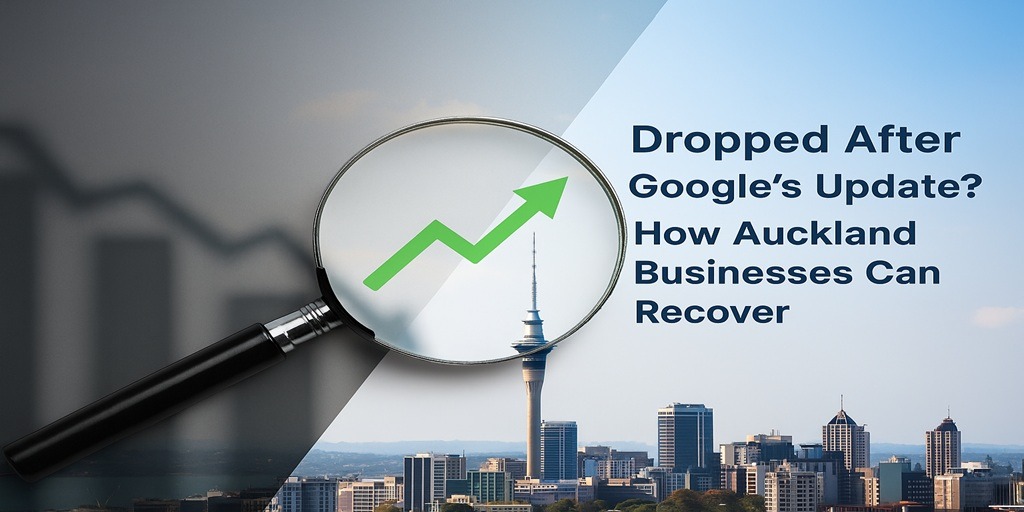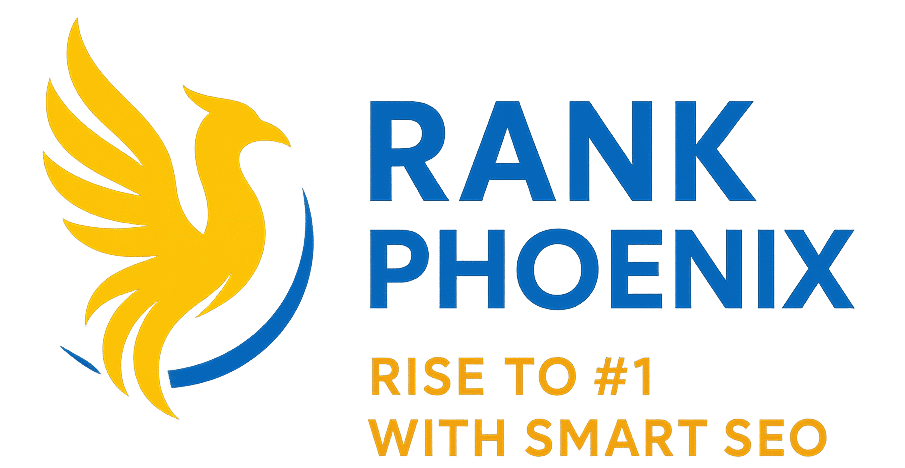Dropped After Google’s Update? How Auckland Businesses Can Recover

GET FREE INSTANT QUOTE
Introduction: That “Oh No” Moment After a Google Update
If your site has suddenly slipped down the rankings after a Google update, you’re not alone. I’ve had calls from café owners in Howick, tradies in Pakuranga, and even a lawyer in the Auckland CBD all saying the same thing: “We were doing fine yesterday… now the phone’s gone quiet.”
Truth is, Google updates are messy. They shuffle the deck. Sometimes even good, established businesses in East Auckland or West Auckland get pushed down. The trick is not to panic, but to figure out what Google’s really looking for now—and then fix the gaps. That’s what this post is about: how Auckland businesses can recover, step by step.
What Exactly is a Google Update?
A Google update is a change in the way Google decides which websites deserve top spots.
Sometimes it’s about speed. Sometimes it’s about content quality. Sometimes it’s about trust. And sometimes it’s about whether your site actually helps the average Aucklander on their phone at 7pm, waiting for fibre to load but stuck on patchy 4G.
From my years in digital marketing here in New Zealand, I’ve noticed updates usually target three big things:
- Content usefulness: Is it genuinely helpful or just fluff?
- Technical health: Does it load quickly, or do people bounce?
- Local signals: Are you showing up properly on Google Maps and getting suburb-specific searches right?
How Do You Know if Your Rankings Dropped Because of an Update?
You’ll notice a sudden, sharp drop in traffic or leads that lines up with the update date.
Here’s what I usually check first for clients:
- Google Search Console: Did impressions and clicks dip the same week the update rolled out?
- Analytics: Did organic traffic suddenly nosedive?
- Competitors: Did they rise while you fell? That’s often the giveaway.
- Patterns: Are only certain pages (like suburb pages or service pages) affected?
I once worked with an electrician in Manukau. His homepage stayed steady, but every single suburb landing page tanked right after an update. That told us Google had changed how it judged “local relevance.”
Why Do Auckland Businesses Drop After Updates?
Most drops happen because the site isn’t meeting new quality standards—or competitors got sharper.
Let me give you a few Auckland-flavoured examples:
- Thin content: A generic “plumber in Auckland” page won’t cut it. Google wants “blocked drain repair in Glen Innes” with detail that actually helps.
- Slow mobile speed: On fibre your site looks fine, but plenty of folks are still searching on 4G from the bus. If your page takes 5 seconds, you’ve lost them.
- Weak trust signals: No reviews, no author bios, no proof you actually know what you’re talking about.
- Messy Google Business Profile: Wrong hours, no suburb coverage, or inconsistent name/address details across directories.
- Old SEO tactics: Keyword stuffing, spammy backlinks—if they’re still lurking, you’ll get hit.
How Can You Recover Rankings After a Google Update?
Recovery isn’t about a quick hack. It’s about building a stronger, more helpful presence.
Here’s the exact roadmap I use for Auckland clients:
Step 1: Run a Full Audit
Crawl your site with Screaming Frog or SEMrush. Fix broken links, thin pages, and technical errors.
Step 2: Improve Content
- Rewrite thin pages into helpful, suburb-specific guides.
- Answer real customer questions in plain English.
- Add FAQs optimised for voice search (people are literally asking “Hey Google, who’s the best café near me in North Shore?”).
Step 3: Nail Core Web Vitals
- LCP (Largest Contentful Paint): Page should load in under 2.5 seconds.
- INP (Interaction to Next Paint): Buttons and taps must respond instantly.
- CLS (Cumulative Layout Shift): Stop elements from jumping around while loading.
Step 4: Optimise Local SEO
- Fix your Google Business Profile categories.
- Get suburb-specific reviews (e.g., “best dentist in Pakuranga”).
- Keep your NAP details consistent across directories.
Step 5: Build Authority
- Add clear author bios.
- Show off case studies, testimonials, or photos from real jobs.
- Earn backlinks from trusted NZ sites (local chambers, industry directories, even Trade Me property blogs).
Should You Change Course or Stay Steady?
It depends on whether your foundation was solid or shaky.
Here’s a quick comparison:
Situation | What to Do |
Spammy links + keyword stuffing | Scrap it, rebuild with clean SEO |
Thin, generic content | Expand into suburb-specific, helpful guides |
Decent SEO but weak technicals | Fix Core Web Vitals + mobile speed |
Solid strategy but minor drop | Stay consistent, improve reviews |
The catch? Making panicked, drastic changes can do more harm than good. Focus on steady improvements.
A Real Story: From Drop to Bounce-Back
One client, a pest control business in East Auckland, lost nearly half its organic leads after an update. They were frustrated—especially since they’d invested in SEO for months.
We ran an audit and found the main issues were:
- Slow site on mobile.
- Weak suburb landing pages.
- A Google Business Profile with old categories.
We fixed Core Web Vitals, rewrote pages for suburbs like Botany and Howick, and encouraged reviews that mentioned those areas. Within three months, calls picked up again. By month six, they weren’t just back where they started—they were ahead.
Frequently Asked Questions
Why did my Auckland business website drop in Google rankings after the latest update?
Drops usually happen when your site isn’t meeting Google’s new technical or content standards.
Here in Auckland, I’ve seen hospo sites in Ponsonby lose visibility just because their menus took forever to load on 4G. In another case, a tradie in Pakuranga fell out of Maps results simply because their Google Business Profile was half-finished.
Truth is, updates are less about punishment and more about rewarding the businesses that stay current. If your content is stale or your technical SEO hasn’t been touched in years, a rankings dip is pretty common.
- Audit Core Web Vitals: LCP, INP, CLS
- Update local content and suburb pages
- Check for crawl issues with Search Console
- Optimise your Google Business Profile for Maps
- Review backlinks and clean out spammy ones
Tip: At Rank Phoenix we often find it’s small, hidden issues—like blocked scripts—that drag a site down. Fixing them can bring you back up fast.
How long does it take to recover from a Google algorithm update in New Zealand?
Most Auckland businesses see signs of recovery in 8–12 weeks, with real traction in 3–6 months.
Recovery isn’t instant because Google has to recrawl your site and update field data. For example, a café in Manukau saw early traffic bumps in week ten, but real bookings didn’t pick up until month four.
The catch is it depends on your niche. If you’re in the crowded CBD legal market, expect longer timelines than a North Shore plumber with fewer competitors.
- Early movement: 8–12 weeks
- Stronger gains: 3–6 months
- Faster if technical fixes are done quickly
- Watch Search Console impressions for leading signs
- Keep momentum with steady updates
Tip: At Rank Phoenix we set 90-day milestones so you know exactly where you stand during recovery.
What SEO fixes should Auckland businesses make after losing rankings in Google’s update?
Start with technical clean-up, then refresh content and boost your local signals.
I worked with a Howick gym that bounced back just by fixing their slow LCP and building suburb pages. In contrast, a North Shore retailer saw results only after we refreshed outdated product copy.
The point is, you’ve got to get the technical side sorted before content improvements really stick. Once the site is fast and crawlable, local content and Maps work make the difference.
- Run a full technical SEO audit
- Fix Core Web Vitals (LCP, INP, CLS)
- Refresh suburb landing pages
- Optimise Google Business Profile with photos/reviews
- Remove spammy backlinks
Tip: Rank Phoenix starts with template-level fixes—because one clean template often fixes hundreds of pages at once.
Do I need an SEO consultant in Auckland to recover from a Google penalty or update drop?
Yes—an SEO consultant saves you time and avoids costly mistakes.
I’ve seen too many Auckland businesses panic, delete pages, or stuff keywords, only to make things worse. A CBD law firm I worked with lost months trying DIY fixes until we stepped in with a structured audit.
The reality is, an SEO consultant brings experience with penalties, audits, and Maps SEO. They also understand local quirks—like Trade Me traffic and weekend hospo spikes—that generic advice often misses.
- Get a technical audit done fast
- Diagnose penalties vs. algorithm shifts
- Prioritise fixes that bring ROI
- Avoid risky shortcuts or guesswork
- Tap into proven Auckland-specific tactics
Tip: At Rank Phoenix, we focus on practical fixes that lead to more calls, not just higher rankings.
How can Google Business Profile optimisation help Auckland businesses recover after an update?
A strong GBP boosts Maps visibility, often faster than website rankings.
Take a takeaway in Pakuranga—its website slipped after an update, but with fresh photos, reviews, and the right categories on Google Business Profile, it still showed top of “near me” results.
Here in Auckland, Maps is where locals decide where to eat, shop, or book services. A tidy GBP often means the difference between a phone ringing or silence.
- Update service areas (Howick, Manukau, North Shore)
- Add fresh images regularly
- Collect suburb-specific reviews
- Keep categories and hours accurate
- Answer GBP Q&As with real detail
Tip: Rank Phoenix uses heatmaps to show where you appear on Maps—it’s a quick way to see gaps and opportunities.
What is the cost of hiring an SEO agency in Auckland to recover rankings after a Google update?
Expect to pay $800–$3,000 per month, with audits from $1,500–$4,500, and Maps projects $1,500–$6,000.
For example, a Glen Innes plumber recovered with a $2,000 Maps campaign, while a retail chain in Albany needed a $4,500 technical audit. Pricing reflects how competitive and complex your market is.
Think of it less as cost and more as replacing lost revenue. A single month of missed bookings can be more expensive than investing in recovery.
- Monthly SEO: $800–$3,000
- One-off audits: $1,500–$4,500
- Maps SEO: $1,500–$6,000
- Timelines: 8–12 weeks to see movement
- Competitive niches = higher costs
Tip: At Rank Phoenix we break pricing down line by line, so you know exactly where the spend goes.
Is it better to rebuild content or focus on technical SEO after a Google update hit my site?
Fix technical SEO first, then rebuild or refresh content.
I worked with a North Shore shop where fixing slow CLS improved crawlability, but rankings only recovered after we rebuilt thin product descriptions. In another case, a Manukau tradesman gained traction just by fixing broken sitemaps.
Think of it like plumbing—if the pipes are blocked, adding more water won’t help. Get crawlability right, then focus on content improvements.
- Audit and fix crawl errors
- Optimise Core Web Vitals
- Refresh thin or outdated content
- Add suburb context for locals
- Track changes via Search Console
Tip: At Rank Phoenix, our process is tech-first, content-second—because content only matters if Google can read it properly.
Can small businesses in Auckland recover faster than big brands after a Google update?
Yes—small businesses are more agile and can act faster.
I’ve seen a Howick café recover in 12 weeks by refreshing their site and GBP, while a large retailer in Albany took six months just to push technical fixes through approvals.
Smaller teams can pivot quickly. That agility is often the secret weapon against bigger but slower-moving competitors.
- Move faster on technical fixes
- Focus content on suburb-level intent
- Collect reviews quickly from locals
- Use promotions/events to boost visibility
- Implement changes without red tape
Tip: Rank Phoenix often sees SMEs outperform corporates simply because they can adapt within weeks, not quarters.
What tools or audits should I run if my Auckland site traffic dropped after Google’s update?
Start with a technical audit, then layer in user experience and local SEO checks.
I’ve used Screaming Frog to find blocked pages on East Auckland sites, and PageSpeed Insights to flag LCP issues for a hospo client in Henderson. Pair these with GBP reviews for a full picture.
Without the right tools, you’re just guessing. And here in Auckland, guesswork usually means wasting another quarter of business.
- Screaming Frog for technical crawl
- Google Search Console for coverage
- PageSpeed Insights for Core Web Vitals
- SEMrush/Ahrefs for backlink checks
- GBP audit for Maps accuracy
Tip: Rank Phoenix starts every recovery with a template audit, so the biggest bottlenecks are identified within days.
Where can I find proven case studies of Auckland businesses recovering from Google updates?
Check local SEO agencies, Google reviews, and independent forums for case studies.
For example, one of our East Auckland hospo clients increased foot traffic by 35% after we fixed Core Web Vitals and cleaned their GBP. You won’t get that detail from overseas case studies.
Look for examples that mention suburbs, results, and actual numbers. Vague “ranked higher” stories don’t prove much.
- Local SEO agency websites
- Google Business Profile reviews
- Trade Me forums and business groups
- Ask consultants for references
- Compare before-and-after data
Tip: Rank Phoenix shares real client wins—measured in calls and bookings—not just keyword charts.
Conclusion: Updates Are Opportunities, Not Punishments
If your Auckland business dropped after a Google update, it’s not the end of the road. Think of it as Google nudging you toward a stronger online presence.
By focusing on useful content, technical health, and local trust signals, you not only recover but often come back stronger.
And if you’re not sure where to start? That’s where a local SEO agency like Rank Phoenix steps in. We’ve helped cafés, tradies, and service providers all across Auckland bounce back from algorithm hits—and we can do the same for you.

Rank Phoenix team
Rank Phoenix helps Auckland businesses grow online with proven SEO strategies, local search expertise, and result-driven digital marketing.
